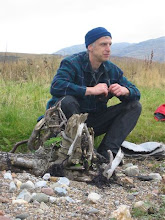There are lots of gulls about. So what ? Well actually they are worth paying a little attention as at this time of year there is a lot happening in the gull world. At Flanders Moss the other day the field next to the Moss was being ploughed and there were several hundred gulls feeding on the freshly turned soil. After a bit of a watch I found 3 types of gulls, common, black-headed and lesser black-backed gulls moving around the field. All these gulls have different annual life strategies but had congregated at the crossroads that is the Carse of Stirling.

Take the black-headed gull. These gulls breed and winter in Scotland in large numbers, about 43000 pairs breed here but 160 000 winter, the wintering birds being local birds and also from all over including England, Iceland and Scandinavia. These birds by Flanders are on the move to their breeding grounds, stopping off on the way for a feed. Back in the 1950's a huge colony of 10-12000 pairs used to nest on Flanders Moss out by the lochan and it was to these birds that people would walk out onto the Moss to collect their eggs. No-one really knows why the colony on the Moss disappeared but it was unlikely to be down to just the egg harvesting.

The common gulls are not namely correctly as they aren't really common and are in fact declining. About 80 000 birds winter in Scotland but in spring up to 200 000 birds move through Scotland from where they winter down south. These birds at Flanders Moss are probably moving through Scotland and onto Scandinavia and Norway especially. Later in April we may see the pair that nested near to the boardwalk at Flanders return. Maybe this is the start of a big colony like the black-headed gulls ?
As for the lesser black-backed gulls, they are fair weather gulls. Apart from a very few birds they all winter in Spain and southern Europe and return to Scotland to breed in March/April. These birds also used to breed on Flanders Moss, the colony growing to at least 4000 pairs before disappearing in the mid-1980s. One theory for their disappearance was the closing down on the small local landfill sites such as the one at Buchlyvie, their food supplies, and the opening of the further away Polmaise dump. Tellingly lesser black-backs now nest on the roofs of industrial buildings in Stirling, nearer to their food sources.
So next time you spot some gulls have a go at trying to identify them and have a think about how far they might have travelled to get where you are seeing them. A bird id book will help you put a name to the gulls, it is far better than me putting photos on the blog.
